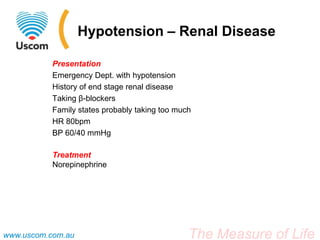Case Study - Adult - Hypotension - Renal Disease
- 1. Hypotension – Renal Disease Presentation Emergency Dept. with hypotension History of end stage renal disease Taking β-blockers Family states probably taking too much HR 80bpm BP 60/40 mmHg Treatment Norepinephrine www.uscom.com.au The Measure of Life
- 2. Hypotension – Renal Disease Treatment Glucagon (β-blocker reversal) Albumin 25 g (volume expansion) www.uscom.com.au The Measure of Life
- 3. Hypotension – Renal Disease Results HR = 80 bpm - unchanged BP = 60/40 -> 81/55 MD = 8 -> 13 SV = 34 -> 49 SVI = 18 -> 26 CO = 2.5 -> 4.1 CI = 1.3 -> 2.1 Post Fluid expansion 50% improvement! Conclusion Rapid, non-invasive assessment and confirmation of therapy. www.uscom.com.au The Measure of Life
Editor's Notes
- #2: Norepinephrine is also used as a vasopressor medication (for example, brand name Levophed) for patients with critical hypotension. It is given intravenously and acts on both α1and α2 adrenergic receptors to cause vasoconstriction. Its effects are often limited to the increasing of blood pressure through agonist activity on α1 and α2 receptors, and causing a resultant increase in peripheral vascular resistance. At high doses, and especially when it is combined with other vasopressors, it can lead to limb ischemia and limb death. Norepinephrine is used mainly to treat patients in vasodilatory shock states such as septic shock and neurogenic shock, while showing fewer adverse side-effects compared to dopamine treatment.[44]http://en.wikipedia.org/wiki/Norepinephrine
- #3: Hypodynamic after Norepinephrine (vasoconstrictor) Low MD - 8 (Typical 14-22) Low SV – 34(Typical 0.9 - 1.75 ml/kg)Low SVI – 18 (Typical 30-55)Low CO –2.5 (Typical 2.5-6.0)Low CI –1.3 (Typical 2.4-3.6)Norepinephrine reduced the CO due to increasing of the SVR.After Fluid expansion – 50% improvement!Low MD -13 (Typical 14-22)Low SV – 49(Typical 0.9 - 1.75 ml/kg)Low SVI – 26 (Typical 30-55)Low CO –4.1 (Typical 2.5-6.0)Low CI –2.1 (Typical 2.4-3.6)Glucagon can enhance myocardial contractility, heart rate, and atrioventricular conduction; many authors consider it the drug of choice for beta-blocker toxicity. Because a glucagon bolus can be diagnostic and therapeutic, the clinician can empirically administer glucagon and check for a response. An upper dose limit has not been established.http://emedicine.medscape.com/article/813342-treatment#aw2aab6b6b2
- #4: SVI 18 -> 26After Fluid expansion – 50% improvement!Low MD -13 (Typical 14-22)Low SV – 49(Typical 0.9 - 1.75 ml/kg)Low SVI – 26 (Typical 30-55)Low CO –4.1 (Typical 2.5-6.0)Low CI –2.1 (Typical 2.4-3.6)



